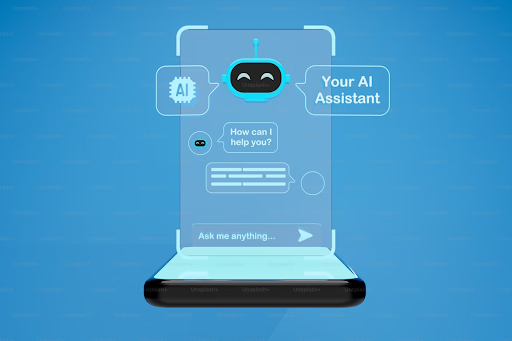We live in a world where modern business cannot do without artificial intelligence (AI). After all, if you don’t use its capabilities, you lose your competitive advantage. Virtual assistants are excellent at automating most work processes, improving customer interactions, and significantly increasing overall efficiency.
The success of AI was confirmed at the 2025 World Economic Forum in Davos, which demonstrated that even on boards of directors, AI agents can be quite effective and even surpass the experience of many experts. When it comes to customer service, AI chatbots are proving their worth.
For example, bots can easily respond to thousands of user requests simultaneously at any time of the day or night. What’s more, they can provide highly personalised responses based on user data analysis. Humans don’t have these capabilities. But they do have more time to tackle more complex tasks. In short, everyone wins when chatbots are implemented – both businesses and customers. The following material will explore this topic in more detail.
Benefits of Chatbots in Customer Service
Today, speed is incredibly valued: quick decisions, instant responses, continuous movement toward a goal. And service must be up to par – fast, accurate, and high-quality. Modern people, especially the younger generation, hate waiting more than anything else.
It is where AI chatbots come in handy, providing users with answers to any questions they may have in a matter of seconds. They can do this easily thanks to the valuable customer data they gather from each interaction.
i. Providing Instant Responses
As mentioned above, speed is one of AI chatbots’ strengths. The faster a chatbot responds to user questions, the more likely the user is to be satisfied and return. This statement works perfectly for typical questions about order status, product range or specific products, product availability, and other questions that do not require human intervention.
Since bots process these requests in real time, freeing up their human colleagues to tackle more complex tasks, the service process becomes much more optimised. A study confirms that 90% of companies found that implementing virtual assistants into their operational processes led to significantly fewer dissatisfied customers.
ii. Strong Point: Customer Insight and Analytics
The strength of AI chatbots lies in their predictability. Humans can make mistakes, get tired, or misinterpret a customer’s question. Bots, on the other hand, are always ready to give accurate, pre-written answers and never make mistakes in standard scenarios. When it comes to personalisation, AI chatbots can also compete with live operators thanks to their experience from past customer interactions.
Knowing their preferences and behaviour in detail, they can better understand the user and provide them with the necessary information as quickly as possible. It allows brands that use AI in their workflows to anticipate user needs and stay one step ahead of competitors through personalisation. Another study claims that 64% of organisations have achieved this personalised approach thanks to chatbots.
iii. Round-the-Clock Availability
Live employees can also adapt to customer requests, express emotions, and find solutions, even for complex requests. But human resources are limited: operators cannot be available 24/7, their training costs money, and on hectic days, employees may not be able to cope with the workload. Virtual assistants can answer questions even at night and on weekends, ensuring customers remain satisfied with the service and won’t switch to competitors.
It is significant for international companies operating in different time zones. In this way, work processes become more optimised and efficient, as machines take over the processing of routine requests – at any time and in any quantity – while live employees handle complex and non-standard issues. This balance between automation and human experience is the key to success in the market.
iv. Personalising Service with AI Chatbots
Why does this article focus so much on personalisation? According to statistics, implementing personalisation can increase sales by 20%. Customers become more loyal when they feel their requests are being heard and that they are receiving special treatment. 80% of buyers are more likely to purchase from companies that have personalised their offers. Most people have a built-in detector for poor brand communication, which can lead to a 79% drop in the likelihood of a sale.
In some cases, machines are still perceived by users as less capable of finding answers to pressing questions or solving problems: as if their range of competencies is limited and they lack the empathy that virtually every living person possesses. In reality, there are cases where sales by a robotic AI employee were four times more effective than those of inexperienced employees who are unfamiliar with the product, have underdeveloped presentation skills, and are rude when communicating with customers.
One such case is the NoForm AI chatbot, which harmoniously combines advanced dialogue algorithms with analytical tools that transform dialogues into helpful information. The bot constantly learns from each interaction with users, quickly adapting to their individual preferences, which makes each interaction more relevant and engaging.
v. Combination of AI Chabots and the Human Factor
One of the most critical problems arising when companies implement AI-based bots is their compatibility with the human factor. Many have concluded that, despite its incredible capabilities, machine intelligence cannot wholly replace human employees. Emotional intelligence, complex and non-standard questions, high expectations – all of this is still beyond the capabilities of bots.
However, this raises a logical question: why replace when you can combine, getting all the advantages and levelling out the disadvantages? And this can be easily done by following simple rules.
- Think through answers to frequently asked questions. To do this, analyse the requests that customers most often make to the support department. Create an FAQ – it can be posted on the website and used for the bot’s script simultaneously.
- Don’t pretend that the bot is a person. Some companies try to disguise a chatbot as a live operator. This tactic will only alienate the customer – they will expect a response from an employee, but will receive template phrases from the bot’s script. Let the customer know who they are communicating with in the very first message, for example: “Hello! I am your personal virtual assistant – I will help you choose a product and answer questions about delivery.”
- Notify customers about deadlines. If you don’t have 24/7 online support but do have a chatbot, enable a situational algorithm. It works like this: a bot responds to a request on Sunday evening. It introduces itself as a bot and lists the tasks it can help with. For questions that require a live operator, the virtual assistant offers to leave a request and promises to forward it to a specialist on Monday morning.
Final Words
The debate over whether chatbots or operators are better becomes irrelevant when businesses use both tools. Bots improve customer service efficiency, enable personalised communication, and reduce staffing costs. However, AI still cannot outperform live employees in emotionally charged dialogues or in solving non-standard issues.
Using both artificial and human components in work processes can be a competitive advantage, helping businesses strengthen customer relationships, increase loyalty, and ultimately achieve market success.
Read More : Cloud Phone System : A Complete Business Communication Guide


